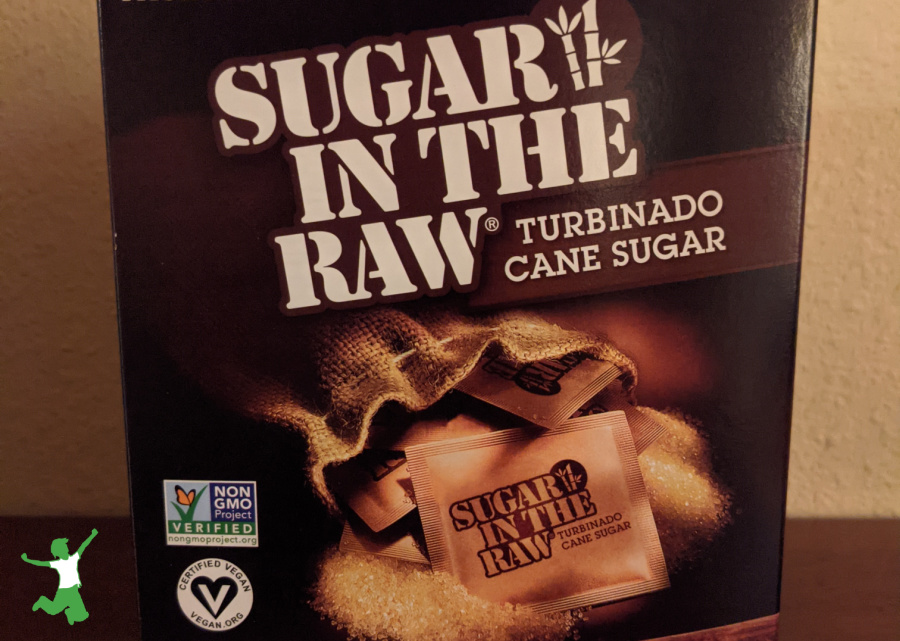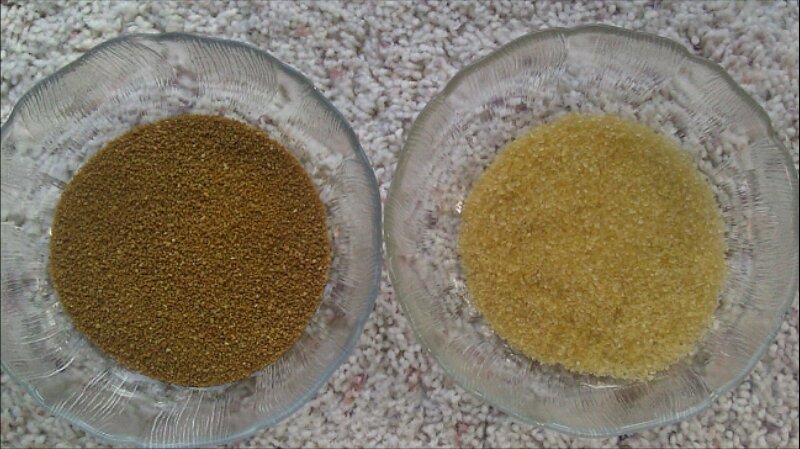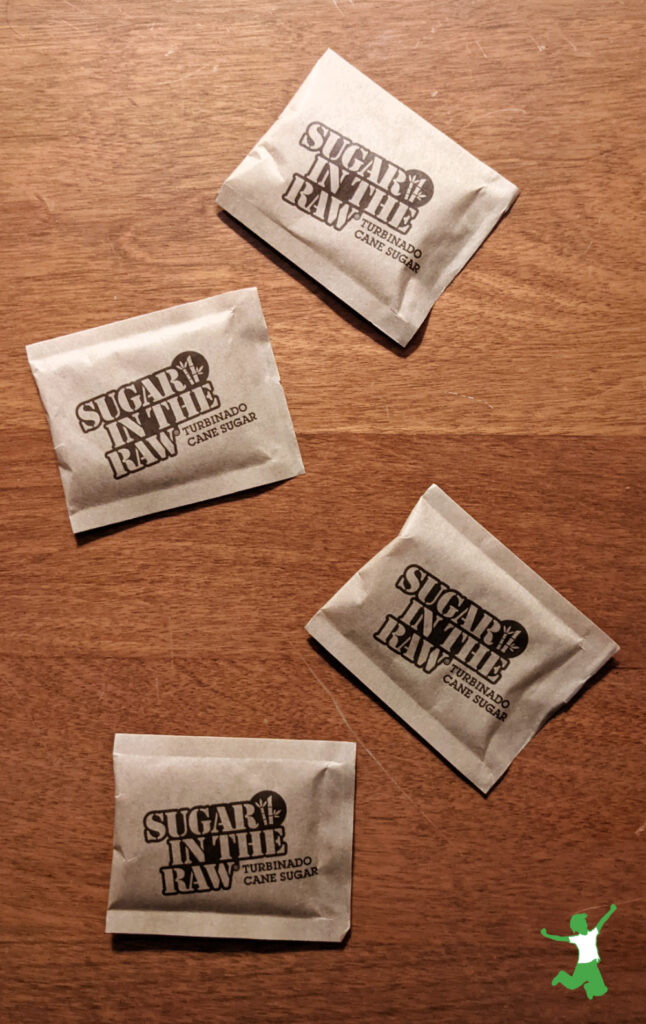Examination of the marketing claim of Sugar in the Raw and whether it is a whole, unprocessed sweetener retaining all the minerals of raw cane juice.

If a food is labeled as “raw”, what exactly does that mean?
To a consumer like me, raw means that the food is completely unadulterated. It has not in any way changed from its original natural form.
In other words, nothing has been added, removed, or heated to a temperature that would change any of the inherent nutritional characteristics.
Unfortunately, to food manufacturers, the definition of “raw” can be quite different.
In fact, raw to Big Food can translate to highly processed, industrialized food!
I’ve written before about how most raw cheese at the store is not raw at all in reality! In addition, cold-pressed raw milk and cold-pressed juice are not actually fresh either.
Sugar in the Raw Marketing Ploy
Another fake raw food at the store that is fooling a whole lot of people is “Sugar in the Raw”. It is also known as turbinado sugar or natural cane sugar.
But what about the “Good Housekeeping” seal of approval that sometimes appears on the box?
Doesn’t that mean that the Sugar in the Raw product is legitimate and to be trusted in its labeling claims?
Apparently not. Here’s what the manufacturer of Sugar in the Raw has to say about its product:
Enjoy sweet moments naturally with Sugar In The Raw®, our all-natural Turbinado sugar grown in the tropics. The hearty, golden crystals are never bleached, so they keep the rich flavor and color of their natural molasses. So go on, stir it in or sprinkle it on. Bake and cook with it too. Whatever you do, just do it naturally with Sugar In The Raw®.
It seems that just because Sugar in the Raw is unbleached makes it raw.
Perhaps that is what the USDA allows when it comes to labeling sugar products.
To me, sugar that is truly raw means much more than just unbleached. It means that nothing has been removed or added as well.
The marketing of this product is so sneaky because it leads the consumer to believe that the natural molasses is intact.
And, for Sugar in the Raw, a small amount of the molasses is indeed intact because it is a darker color than white sugar.
The truth, however, is that MOST of the molasses HAS been stripped away.
Comparison to Sucanat

Check out the picture above which shows a bowl of Sugar in the Raw next to a bowl of sucanat.
Notice the dark brown color of sucanat which is truly unprocessed cane sugar with all minerals, nutrients and molasses intact.
The lighter color of Sugar in the Raw indicates that the manufacturer has removed much of the mineral content.
In other words, the much darker sucanat visually demonstrates that Sugar in the Raw is a fake food masquerading as real.
It is an adulterated product contrary to the sneaky claims by the manufacturer.
What is the Best Cane Sugar?
Looking for the best and most nutritious form of cane sugar for your homemade cookies and cakes?
Sucanat is it! It is the best alternative to white or brown sugar substituted 1:1 in all your recipes.
It is best to bypass Sugar in the Raw or other turbinado sugar brands.
Florida Crystals is another cane sugar brand missing most of the molasses, so beware!
Most White or Brown Sugar is GMO
Another HUGE problem to watch out for is that most white or brown sugar in North America is partially or totally beet sugar. This sweetener is nearly always GMO unless certified organic.
GMO beet sugar is visually and taste-wise completely indistinguishable from white cane sugar.
Is beet sugar healthy? While it may seem so because it comes from a vegetable, the truth is that it is not!
Sugar from sugar beets is nutritionless and contaminated with gut-destroying glyphosate residue. Nearly 100% of farmers growing it use Monsanto’s Roundup Ready sugar beets.
A package of sugar must specifically state that the sweetener is cane sugar or be certified organic, else it is almost certainly a mixture that is wholly or partially GMO beet sugar.
Even brown sugar commonly contains at least some white beet sugar mixed with cane sugar molasses. The molasses from sugar beets is not fit for consumption.
To get the real thing, look for sucanat or sugarcane jaggery. Both are simply dried cane sugar juice with all minerals intact.
Ancestral cultures in India enjoyed these sweeteners for thousands of years.
What is a Safe Level to Consume?
While sucanat is your best choice when trying to find a truly natural and unprocessed substitute for processed cane sugar, be careful not to overdo.
Eating too much sugar can lower immunity, even if natural and unprocessed, in a manner similar to white sugar or partially processed sweeteners like Sugar in the Raw.
In summary, it always pays big dividends to do a little checking before buying into any labeling claims.
Sugar in the Raw is just another clever marketing scheme designed to make money off of consumers who genuinely are trying to improve their diets but don’t have quite enough information to make a completely informed decision.
Where to Find Truly Unprocessed Natural Sweeteners
Need help identifying truly natural, unprocessed whole sweeteners?
Please visit my Shopping Guide for a vetted list of vendors I buy from who offer quality sucanat, jaggery, coconut sugar, raw honey, maple syrup, and other wholesome sweeteners.
Beware that popular “healthy” sweeteners like xylitol and other sugar alcohols as well as brown rice syrup used in many organic foods and baby formula are highly processed. This is why making homemade baby formula is a better choice than commercial brands.









I was under the impression that Rapadura was true sugar in the raw and unrefined state, but is almost impossible to buy. I think Sucanat is still treated and separated from the molasses but then they are brought back together again. Sucanat was the closest thing to Rapadura that could be found here in the U.S. I read that here; http://quirkycooking.blogspot.com/2009/07/rapadura-sucanat-muscavado-turbinado.html
There are similar products to Rapadura, such as Sucanat (USA – a trade name), and Jaggery (India). Sucanat is different to Rapadura in that the sugar stream and the molasses stream are separated from each other during processing, then reblended to create a consistent product, whereas Rapadura is a wholefood product which can vary according to sugar cane variety, soil type and weather. This is why one batch of Rapadura may be lighter or darker than the last batch. (See this diagram) Because Rapadura is not separated from the molasses, it has more nutrients, vitamins and minerals. Jaggery can refer to either whole cane sugar or palm sugar. From what I can understand, it is also heated to higher temperatures, as much as 200 degrees C, which Rapadura is not. Like many of these similar sugars, Jaggery is solidified and formed into cakes, which can then be grated for use.
Sara, I am not disagreeing with you, only curious. I shopped for rapadura the other day and that was the information I found, so I bought Sucanat. If it’s the same thing, that’s great!
Awesome info! Where did you get it?
Refined white sugar gives me nasty migraines. I have not eaten white sugar in over 15 years. Turbinado, evaporated cane crystals, or organic sugar does not give me migraines but I still use it sparingly.
I guess something in the final process of bleaching the white sugar is what’s sets it off for me.
Personally I’m glad I can fall back on the “sugar in the raw” when baking a special treat.
Allie, What in the world made you think refined sugar is bleached?? You are totally clueless like half the other tree huggers on this site. Geez.
Very nicely put. I mean, why give information when you can just insult people?
Are you a Sucanat distributor ? And why make such a big deal out of it ? Personally, I like the Sugar in the Raw. It tastes better than refined sugar, and I use much less of it than I would use refined sugar. And, it’s readily available at all grocery stores, which goes to show you, I’d never even heard of Sucanat until I read this article.
“Sugar in the raw” was called “sugar in the raw” before “raw” became a fad diet/lifestyle. I am sure if they came up with their name now, they would be more sensitive to your delicate nature.
who cares
Good way of explaining, and pleasant paragraph to get information regarding my presentation subject matter, which i am going
to deliver in college.
“Sarah, I’m wondering why Nourishing Traditions Says to use Rapadura but not Sucanat. Sucanat is listed under their ‘sugars to be avoided’ on page 537. Any help on this is so appreciated! I’ve never been able to find Rapadura but I’ve been able to find Sucanat.”
I’m also wondering the answer to this question asked above… any ideas?
“Sugar in the Raw”(tm) Please Harvest Cane w/o Burning
To be delivered to: HC&S
Dear “Sugar in the Raw” folks,
We who buy your product care about the environment. And we’d like to know that you care too. When you burn the cane fields on Maui, it adds to the CO2 and worsens climate change. And the smoke from your burning is damaging the lungs of your workers, your workers’ children and the residents of Maui.
We love your product and want you to change to no-burn harvesting so we can continue to buy it, knowing we aren’t contributing to Global Warming and lung disease.
At my local health stores, they have several different sugars all labeled as “evaporated can juice” ranging in light color (off-white) to very dark (chocolate color). It can be confusing to simply purchase based upon “evaporated cane juice”, color is a good judge, especially if it says sucanat on it. Some brown sugars are really white sugar with some molasses mixed back it, so the sum of the parts don’t equal the whole sugar.
As for fruit, modern fruits have been cultivated for maximum sweetness. A handful of grapes can contain a lot of sugar. If you ever get the chance to eat some wine grapes (merlot, cabernet, etc), you’ll know the difference as they’re quite tart. Sure, fruit is more of a whole food than cookies, but you can overdo it. Everyone is going to have to trust their own gut as to what is right for them. An easy place to overdo it is in fruit juices. We treat fruit like a special treat, like a cookie, not something that we eat on a regular basis and my energy levels have never felt so stable (no highs and lows).
I don’t remember my links on info for agave, but did find these tonight.
She explains why agave is not good, so you can decide for yourself. She also provides a link for the Weston Price Foundation for further explanation.
http://www.foodrenegade.com/agave-nectar-good-or-bad/